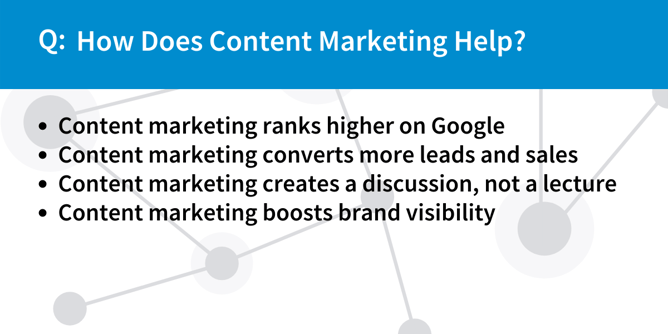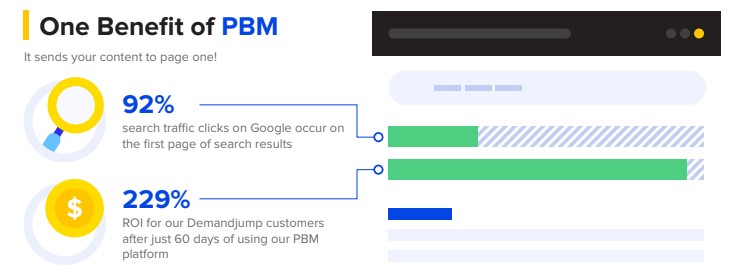Content Marketing Definition and What That Means for Your Brand
When we talk about marketing, it’s impossible to get away from the concept of content marketing. This approach is considered the Holy Grail of audience engagement. Why? Because the content marketing methods used by top brands create a groundswell of participation and awareness that can create huge benefits to ROI and marketing spend.
But, for those of us that may just be getting started, it’s important to first give a good content marketing definition. So, what is content marketing? What can we learn from the content marketing meaning? And what are some examples of what this looks like once it’s put into practice? Let’s examine all of these as we reach to discuss the content marketing definition, in all its glory.
What Does Content Marketing Mean?
What is content marketing in simple words? Content marketing is the practice of using your own published online materials to provide measurable value to your audience. But the true definition goes far deeper than that. Content marketing is about a mindset, namely, connecting directly with a specific audience in order to attract their attention, provide them with value, and nurture them towards a sale. This audience may already be fans of your brand, in which case the objective here is retaining them; conversely, you may be aiming for individuals who are unfamiliar with your brand, in which case you’re looking to drive interest towards your content. Though the end-goal may be the same, we make these audience distinctions because the content used will play specific roles in the process.
A key word used in this definition is “valuable.” How do we know if a piece of content is valuable, and therefore working within a content marketing strategy? One way to tell is whether a reader or audience member wants to engage with the content, as opposed to having to. When content marketing is done correctly, you’ll be producing pieces that could provide use to many different readers, as opposed to simply being another part of an advertisement campaign.

Content marketing isn’t supposed to promote your brand or product specifically. Instead, these pieces of content should be created with the goal of inspiring interest around your brand. In a larger sense, content marketing is about creating and crafting a narrative that appeals to readers and consumers and makes them want to engage even more.
In defining content marketing, we also need to look at this from an overhead perspective. Delivering value via content marketing is more than just a one-off attempt. In order to truly capture the needs of the audience and make sure that our content is reflecting that understanding, content marketing needs to be a commitment from a brand to its audience. In other words, content marketing needs to be consistent. This is what separates content marketing from ad campaigns or marketing initiatives. This is that state of mind we spoke about, the commitment to providing valuable content that engages readers without overtly selling or directly marketing specific products and services.
People want to feel cared for, and oftentimes marketing and advertising can alienate folks, making them feel like a statistic or sales figure. With content marketing, we’re able to communicate our ethics and goals as brands without sounding like a radio advertisement. This is accomplished through a variety of ways and content types.
Imagine you are the marketing director for a chain of sporting goods stores. Typical marketing strategies would push for you to feature promotions, buy ad space on tv and radio, put up billboards, and send targeted emails, all with the general focus of promoting the store and encouraging people to come in for some good deals on tennis balls and running shoes.
But what if instead (or in addition), you produced a blog series about choosing the right tennis racket? Or video content that broke down the history of cleats in football? Or even went outside the box, and sponsored a podcast with local sports writers about the local high school or college level fencing teams? These don’t say anything about the sports store, they just provide interesting content for folks to read, watch, and listen to. And while they’re becoming fans of your content, they’re also aware that it’s your brand that’s responsible. Now imagine, those same fans suddenly need a piece of sports equipment; where do you think they’ll go? Whose insights will they trust to make the right purchase decision? That is content marketing. We’re creating ground swells through a catalog of relevant, valuable, and enjoyable content in order to create a fan base that feels valued by a brand as opposed to sold to.
Where Does Content Marketing Come From?
A good way to understand content marketing is to look at examples throughout history. The concept of connecting with audiences is something that is nothing new, as writers through the ages have attempted to do such things in their storytelling. In 1732, Benjamin Franklin began publishing the now famous Poor Richard's Almanac, which provided readers with weather forecasts, crop trends, household tips, puzzles, wordplay, and other generally interesting bits of reading. However, you may be interested to know that the point of this publication was to promote his printing business. This is one of the first and most formative types of content marketing.
There are many other instances of pre-digital content marketing. In 1801, the bookstore Librairie Galignani created a newspaper that featured articles by influential writers and other thinkers all on the topic of literature. They also opened a reading room that welcomed all fans of reading to come and peruse their favorite titles, have coffee, and generally converse about topics related to books. Again, these ideas were not advertising the bookstore directly, but simply connecting with an audience and providing them with value through marketing efforts. In modern day terms, we might think of a company creating a monthly newsletter with industry experts talking about related issues; additionally, the reading room is similar to that of a social media channel, where followers can engage in online discussions about industry topics, all under the umbrella of a brand.
Generally, marketing historians point to two publications as being the true start of content marketing. The first is The Furrow, a magazine by John Deere, first published in 1895. This publication discussed issues related to farming and farming equipment. Though it featured product breakdowns, it appealed to readers across the country who had a vested interest in the farming industry. The second example many historians point to is that of the Michelin Guide, first published in 1900. This magazine had the sole purpose of helping weary travelers know where to lodge, dine, stop for gas, and generally which points of interest they may want to check out along the way of a trip. That’s why a tire company is today’s leading arbiter of taste with their Michelin Star system for world-class restaurants. Both of these publications are still running today. Why? Because they’re forms of content marketing, and they prove the point that readers and audience members value more than advertising when engaging with brands.
Content marketing examples can also be found throughout the 20th century, such as:
- Sears’ radio program The World’s Largest Store
- Jell-O’s cookbook The Jell-O Recipe Book
- Lego’s magazine Brick Kicks
- Weight Watchers Magazine
- G.I. Joe’s animated series
As we move into the digital age of marketing, content marketing began to come into view as the wave of the future once traditional advertising methods fell short. Let’s take a look at how content marketing has been proven to be a reliable source of audience engagement.
How Does Content Marketing Help?
Now that we understand the definition of content marketing, as well as where this concept came from, we can start to examine why and how this approach would help a modern business or brand. There are countless blogs and infographics on this topic, but for the purposes of this discussion about the definitions of content marketing, let’s whittle it down to five main selling points.

1. Content marketing ranks higher on Google
Google’s search algorithm is one of great debate, as digital marketing gurus spend tons of time and resources promising the secrets to crack its code. However, there are some easy ways to tell that great content that provides value simply ranks higher on Google. For instance, written pieces that are relevant to ranking keywords receive higher placement on search results. This tells us that as opposed to SEO keyword stuffing, Google is looking to promote the pages that feature content written about and around these centralized topics. Additionally, pages that are often linked to other pages get higher rankings. From this, we can surmise that creating authoritative and informative content that other creators and industry folks can cite means more exposure for your brand.
2. Content marketing converts more leads and sales
Let’s talk about the content marketing funnel, which separates readers into three categories: Awareness, Consideration, and Decision. When we approach marketing from this perspective, it becomes easier to create content that nudges readers toward the Decision stage, and therefore closer to conversions and sales. This happens in two ways:
- By providing content that creates value surrounding your insights and
- By creating and nurturing a relationship with audience members.
Rather than investing money in cold calls and outbound lead generation, your sales team can instead work on the folks who are contacting you for business, not the other way around. And all of this comes from creating great content as part of a content marketing strategy.
3. Content marketing creates a discussion, not a lecture
Throughout classrooms and educational environments, teachers have long-since relied on the Socratic Method to help students better understand key concepts. This approach calls for discussion and dialogue between teacher and student, with the idea that this kind of intellectual interaction will help the audience to better comprehend not only how things work but provide a level of importance. In the same sense, content marketing can create a discussion of why a product or service might exist. This can lead to more engagement from the reader or customer, and generally create a more palatable marketing experience.
4. Content marketing boosts brand visibility
Lastly, content marketing means more individuals interested in your brand. By crafting content that stands alone as valuable and interesting, more folks will want to know the next piece of cool content your brand decides to publish. This can happen in a variety of ways, but one good example is the increase in social media followers you have. We know that 71% of users with a good social media experience with a brand are more likely to recommend it to a friend or family member. This illustrates how great content and heightened brand awareness leads to a more organic growth in your company’s position in the marketplace.

What Are Examples of Content Marketing?
Content marketing assets can come in a variety forms and genres, including written posts, video content, audio content, and mixed media. In fact, it can be said that content marketing is really only limited by the imagination of the marketers behind it. One great example is Coca Cola and their Coca Cola Journey campaign. This collection of content focuses broadly on the historical growth of the brand, and pulls together tons of engaging content, including memorable advertisements, logos, articles, inventions, recipes, and commercials, all in a fascinating exploration of both the beverage and its place in American culture. This is all organized on a massive website, which users can explore and enjoy without being told “Buy a Coca Cola today!” Instead, this content marketing example inspires interest and adoration for the brand without a single traditional advertisement.
Because there are so many different types of content out there, let’s take a look at some of the most popular forms of content and how they might be used in a content marketing strategy. We spoke earlier of an example involving a chain of sports stores. Let’s expand on this illustration and think about content marketing for a large online sports equipment company.
- Blogs: These are often used to provide detailed information and educational content, so the sports equipment company might consider a series of blogs about the history of a single sport, and dive into a more journalistic approach that details the development of all the equipment used in modern American football. Perhaps, how did the early years of football and its lack of padding give way to today’s focus on preventing spinal cord and head injuries?
- Video: Video content can provide enriching value for audience members throughout the marketing funnel. There’s a huge demand for this content, as 54% of customers want more video from brands and advertisers. The sports equipment company, then, might produce a series of videos dedicated to getting the right fit on a mouthguard or breaking in running shoes.
- Audio: In modern content marketing, this would be where something like a podcast or radio show would come in. A sports equipment company might have a podcast where their hosts review hilariously bad or awkward sports advertisements of the past or attempt to dream up bizarre marketing campaigns for Bo Jackson, all in the name of comedic content.
- Infographic: These provide a great deal of value both for B2C and B2B, as they combine great statistical analysis with graphics and colorful design. So, an infographic for a sports equipment company might be positioned toward the individual customer, such as one about stats showing how the right type of batting gloves leads to better hitting averages in baseball; conversely, the infographic could appeal to a larger audience, like a school’s athletic director, and demonstrate how buying certain products in bulk could lead to overall savings for a school’s sports department.
In general, it’s important to remember that whatever content marketing type you’re choosing, it should provide information that would be generally appealing to anyone consuming it, not just someone who is shopping with your brand.
Let DemandJump Unlock the Door to Your Customers’ Content Marketing Journey
Whether you’re just getting started in content marketing or you’re trying to improve your attempt to write great content, you need the right data and analytics to get started. This is precisely where a trusted partner like DemandJump comes in. With detailed reports on audience behavior, competitor research, and customer journey, you can get a better understanding of your audience in order to produce content that feels customized, personalized, and relevant.
This industry-defining platform is the ultimate way forward for anyone involved in content marketing. While you may know why it’s important and valuable, we’re looking to help show you how to get things going. With that in mind, sign up for your free trial today.












